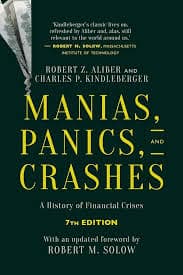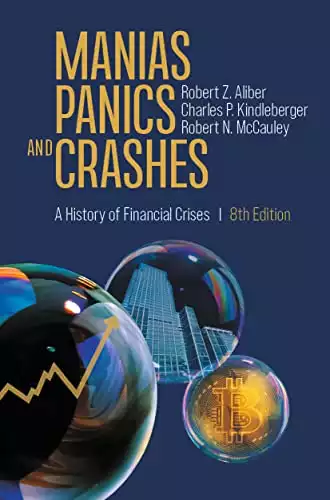Overview : Manias, Panics, and Crashes
- Book Title: Manias, Panics, and Crashes
- Author: Charles P. Kindleberger
- Publication Date: September 2020
- price: $35.33
- Pages: 350
Overview of the Book
The book was originally authored by Charles P. Kindleberger, a renowned economic historian and professor at MIT, known for his expertise in financial crises and international economics. It has been revised and updated by Robert Z. Aliber, an esteemed economist and expert in international finance.
Introduction
In the ever-evolving world of finance, understanding the cyclical nature of markets is crucial for investors, economists, and policymakers alike. Charles P. Kindleberger's "Manias, Panics, and Crashes: A History of Financial Crises" offers a timeless exploration of these financial phenomena, providing invaluable insights into the mechanics of market instability.
Book Summary
Originally published in 1978 and subsequently updated by Robert Z. Aliber, this seminal work delves into the recurring patterns of financial crises throughout history. Kindleberger meticulously examines various economic episodes, from the 17th-century Tulip Mania to modern market crashes, revealing the universal human tendencies that drive speculative bubbles and their inevitable bursts.
"There is nothing so disturbing to one's well-being and judgment as to see a friend get rich."
This quote encapsulates the psychological underpinnings of financial manias, highlighting the role of human emotion in market dynamics.
Analysis of Themes
The Anatomy of Financial Crises
Kindleberger presents a comprehensive framework for understanding financial crises, breaking them down into five stages: 1. Displacement 2. Boom 3. Euphoria 4. Crisis 5. Revulsion This structure provides readers with a roadmap to identify potential market bubbles and anticipate their consequences. For instance, the recent cryptocurrency boom and subsequent volatility can be analyzed through this lens, offering insights into market trends and investor behavior.
Psychological Factors in Market Behavior
The book excels in its exploration of the human elements driving financial instability. Kindleberger argues that emotions like fear and greed play pivotal roles in market dynamics, often leading to irrational decision-making and herd behavior. This analysis is particularly relevant in today's digital age, where social media and rapid information dissemination can amplify market sentiments.
Historical Lessons for Modern Investing
By drawing parallels between past and present crises, Kindleberger emphasizes the importance of learning from history. This approach is invaluable for personal finance management and investment strategies, offering readers a broader perspective on market cycles and risk assessment.
Writing Style
Kindleberger's writing strikes a balance between academic rigor and accessibility. While some sections may be dense with historical details and economic terminology, the overall narrative remains engaging. The author's use of anecdotes and real-world examples helps illustrate complex concepts, making the book approachable for readers with varying levels of financial expertise.
Strengths and Weaknesses
Strengths:
- Comprehensive historical analysis - Insightful framework for understanding market cycles - Relevant to both historical and contemporary financial events - Valuable lessons for investors and policymakers
Weaknesses:
- Some sections may be challenging for casual readers - Earlier editions lack coverage of recent financial crises (addressed in updates)
Comparison to Other Works
"Manias, Panics, and Crashes" stands out in the field of financial literature for its historical depth and analytical framework. While books like Robert Shiller's "Irrational Exuberance" focus more on contemporary market psychology, Kindleberger's work provides a broader historical context. Compared to more practice-oriented books like Benjamin Graham's "The Intelligent Investor," Kindleberger's approach is more theoretical but equally valuable for developing a comprehensive understanding of market dynamics.
Relevance to Modern Finance
The book's insights remain highly relevant in today's financial landscape. Its analysis can be applied to: - Cryptocurrency markets and their volatile nature - The impact of social media on stock market trends - Personal investing strategies in a globalized economy - Understanding and navigating banking crises For those interested in personal finance and investing, the book offers a foundation for developing robust, long-term strategies that account for market cycles and potential crises.
Highlights from Manias, Panics, and Crashes
- Market bubbles: Explores the causes and patterns of speculative manias and crashes.
- Psychological factors: Highlights how investor psychology drives market extremes.
- Historical examples: Analyzes past financial crises like the 1929 stock market crash and the dot-com bubble.
- Panic behavior: Examines the rapid shift from optimism to fear in market downturns.
- Regulatory role: Discusses the impact of regulations on preventing or worsening crises.
- Market cycles: Stresses the inevitability of boom-and-bust cycles in financial markets.
Conclusion
"Manias, Panics, and Crashes" is an essential read for anyone seeking to deepen their understanding of financial markets. Its comprehensive analysis of historical patterns, coupled with insights into human behavior, provides readers with tools to navigate the complex world of finance. Whether you're a seasoned investor, a student of economics, or simply interested in understanding market trends, Kindleberger's work offers timeless wisdom and practical insights.





